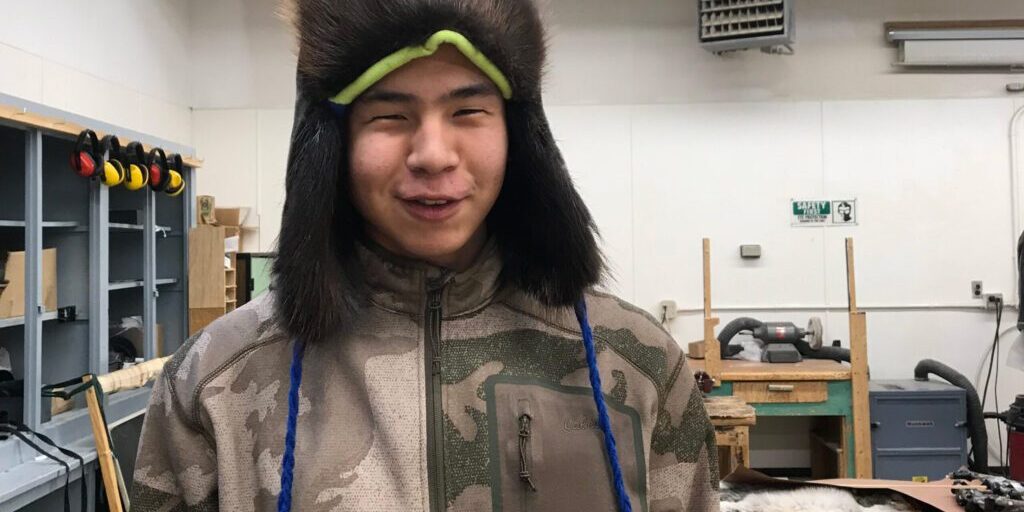During Winterim, the annual 2-week winter elective program at Nome-Beltz High School, students end their typical schedules early to attend an elective every afternoon instead.
This year, Winterim ran January 14-25 and offered a range of classes including two uniquely local subjects: Alaska Native Leadership and Making Seal Skin and Beaver Hats.
KNOM’s Katie Kazmierski reports:
Students file into Phyllis Walluk’s Winterim class, and they immediately get to work. As they talk and laugh with one another, they are making their very own seal skin and beaver hats. They stitch their hats by hand while their teacher looks on, ready to help anyone needing assistance.
“Phyllis’s classes are always the best classes for Winterim, ‘cause you get to make something and take it home and use it.”
That’s Sierra Anderson, a senior at NBHS. She talks as she sews the fleece lining onto her seal-skin hat. She says she would’ve liked to take Walluk’s mukluk-making class last year, but it was full. Evidently, Walluk’s classes are in high demand.
Walluk regularly teaches a course called “Alaska Native Art and Culture,” in which students start off the quarter making small pieces, gradually adding on more sewing and beading, working up to making things like kuspuks, mittens, or hats. Walluk says the Winterim class is different: she had to think of what the students could feasibly make in two weeks’ time.
“What I tried to do is I tried to let them make something for Winterim that they can wear.”
Walluk called the kids in her class “lucky.” NBHS provides funding for all of the materials, and as Walluk puts it, the students are doing the same things their ancestors did years ago.
“It is something that everybody needs to know how to do, and it’s good for them to know that they can make clothing from the furs they can catch. They can prepare, they can tan, and they can make clothing out of them.”
Out of the workshop and just down the hall, Michael Hoyt’s Alaska Native Leadership class is taking a short break. That doesn’t stop kids from practicing counting in Iñupiaq, after Meghan Topkok stopped by the class for a quick lesson.
“…Wait how do you count?”
Hoyt is the advisor for NNYLO, or Nome Native Youth Leadership Organization. He says his Winterim class was meant to be an extension of that — having a time to focus on things like indigenous values and issues.
“…and how can we address them using our values; how can we look at heroes from the past years and the present that have addressed these issues using our values, using our culture, to make sure that we’re addressing these things properly.”
During its two-week duration, the class incorporated some Iñupiaq language lessons, discussion on Iñupiaq values and how to use them in day-to-day life and education.
The class spent a chunk of time looking at issues relevant to Alaska Natives as identified by the Inuit Circumpolar Council (ICC).
“…looking at the issues that they’ve identified at the Utqiagvik Declaration this past year in 2018. So they [the ICC] identified about 10 different issues that have an impact on Inuit across the circumpolar and what they want to do about that, so we’re looking at those as a class and kind of asking, ‘what can we do to address that here in Nome? What can we do to identify similar situations or similar solutions?’”
On the day I visited, Hoyt showed the class a video on a language immersion school down in the Lower 48, and class conversation ensued on how aspects of it could be brought to Nome. One student brought up how she’d like to see more teachers incorporating Iñupiaq into their classroom like Hoyt, beyond mere posters on the wall.
For Hoyt, who speaks a bit of Tlingit and incorporates that into his classroom as well, it’s exciting to see how eager the kids are to learn their language.
“They are really, really excited about learning Iñupiaq and being able to introduce themselves — they are so excited about that. And for me, that was a big reason I wanted to get into education was language learning and language teaching. So I may not know a whole lot about Iñupiaq specifically, but seeing them excited about it made my day.”
Whether they walked away with a hat or an idea, students in both Walluk and Hoyt’s classes ended Winterim with an experience unique to Western Alaska, and to Alaska Native culture.
Image at top: Nome Beltz student Ethan Seeganna poses with his finished seal skin and beaver hat made in Phyllis Walluk’s 2019 Winterim class. Photo: Katie Kazmierski, KNOM.

Posters in Phyllis Walluk’s classroom at Nome Beltz High School. Photo: Katie Kazmierski, KNOM. 
Siberian Yupik labels in the classroom of Phyllis Walluk, who is Siberian Yupik and from Gambell, Alaska. “Qiipaq” translates to “thread,” and “Pumsuukeghtan” means “scissors.” Photo: Katie Kazmierski, KNOM. 
High school students hard at work sewing their seal skin and beaver hats. Photo: Katie Kazmierski, KNOM.




